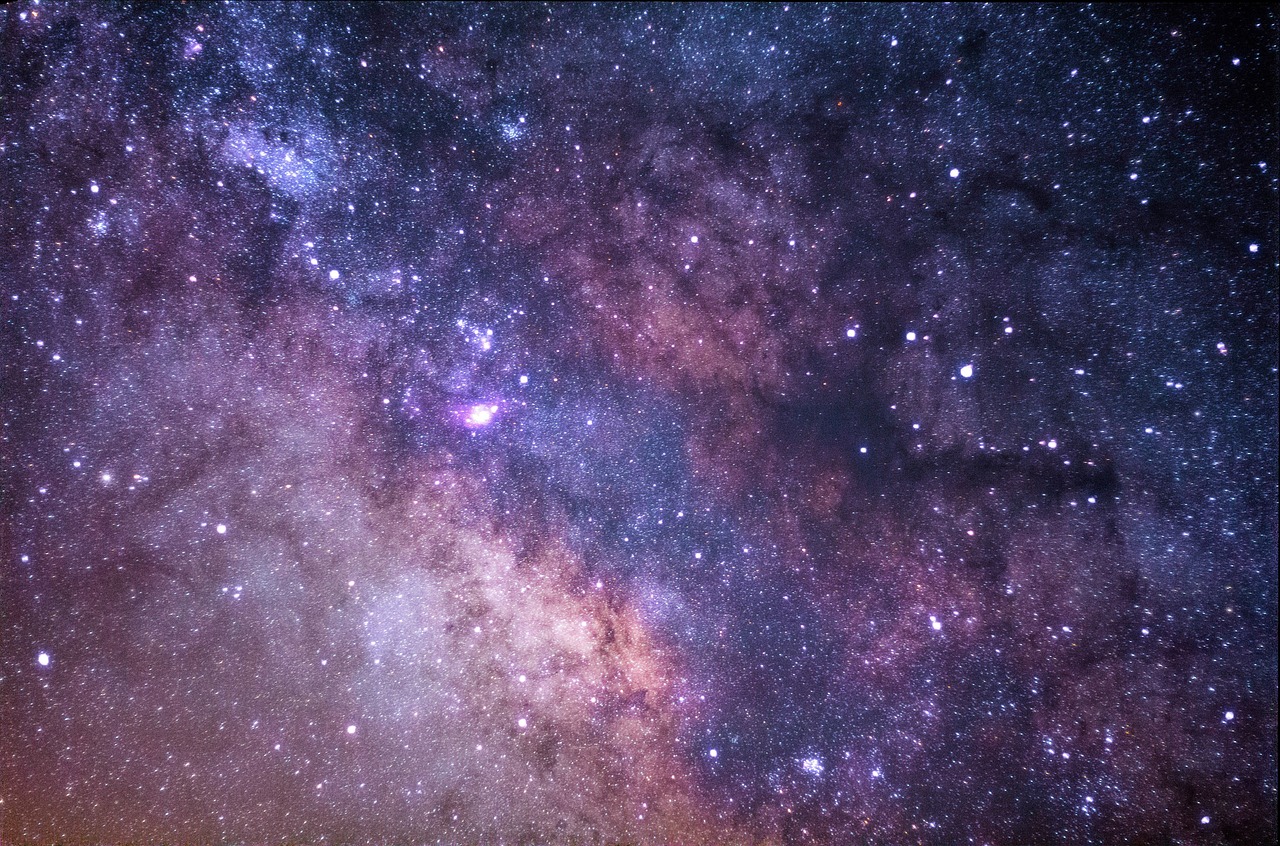- There are more stars in the universe than grains of sand on all the beaches on Earth. That’s at least a billion trillion.
- A black hole is created when big stars explode. Its gravitational force is so strong that nothing can escape from it – luckily the closest black hole is about 10,000 light-years from Earth.
- The universe has the same temperature everywhere. It is about 2.7 Kelvin, which is equivalent to -270.45 degrees Celsius or -454.81 degrees Fahrenheit.
- 95% of the universe is invisible. Only 5% of the universe is made of normal matter that we can see and touch. The rest is dark matter and dark energy, which are mysterious substances that we don’t fully understand.
- The universe was born in a massive explosion called the Big Bang. It happened about 13.8 billion years ago and created space, time, matter and energy.
- The Earth is tiny in comparison with the rest of the universe – it could fit into the sun 1.3 million times.
- The moon is the reason why we have tides and waves on Earth. Along with the sun, it moves billions of tonnes of water each day.
- A day on Mercury lasts longer than its year. Mercury moves around the sun faster than any other planet – making its year the equivalent of 88 Earth days. While a day on Mercury – the interval between one sunrise and the next – lasts 176 Earth days.
- In 2006, Pluto was reclassified as a ‘dwarf planet’ after 76 years classified as the outermost planet in our solar system since its discovery in 1930.
- The universe has no centre and is constantly expanding (getting bigger) every second – making it impossible to reach the edge.
- The universe’s expansion is accelerating. Mysterious dark energy is not only thought to be driving the expansion of the universe, it appears to be pulling the cosmos apart at ever-increasing speeds.
- The core of the Sun has a temperature of about 15 million degrees Kelvin. That’s about 27 million degrees Fahrenheit or 15 million degrees Celsius.
- The Sun makes up more than 99% of the mass of our solar system. It is so huge that it could hold about 1.3 million Earths inside it.
- The Sun rotates faster at its equator than at its poles. This is because the Sun is not a solid body, but a ball of plasma (hot gas). The equator takes about 25 days to complete one rotation, while the poles take about 36 days.
- The Sun produces energy by nuclear fusion. It converts hydrogen into helium in its core, releasing enormous amounts of heat and light.
- There are more than 100 billion galaxies in the observable universe. Each galaxy contains billions or even trillions of stars, planets, moons, asteroids, comets and other objects.
- The largest known galaxy is IC 1101. It has a diameter of about 6 million light-years, which is about 60 times larger than our Milky Way galaxy.
- The smallest known galaxy is Segue 2. It has a diameter of only about 1000 light-years, which is about 100 times smaller than our Milky Way galaxy.
- The Milky Way galaxy has a supermassive black hole at its centre. It has a mass of about 4 million times that of our Sun and a diameter of about 44 million kilometres, which is about three times larger than Pluto’s orbit.
- The Milky Way galaxy is part of a group of galaxies called the Local Group. It contains about 50 galaxies, including our nearest neighbours Andromeda and Triangulum.
- The Sun is not yellow, but white. It appears yellow to us because of the Earth’s atmosphere, which scatters blue light more than red light.
- The Sun accounts for 99.86% of the mass of our solar system. The rest is mostly made up of the planets, especially Jupiter, which is the largest and most massive planet.
- The Sun is not a perfect sphere, but slightly flattened at the poles. This is because of its rotation, which causes a centrifugal force that bulges the equator.
- The Sun is not burning, but fusing. It does not use oxygen or fire to produce energy, but converts hydrogen into helium through nuclear fusion, which releases enormous amounts of heat and light.
- The Sun is not stable, but variable. It has cycles of activity that affect its brightness, temperature, magnetic field and solar wind. The most noticeable signs of these cycles are the sunspots, which are dark patches on the surface caused by intense magnetic activity.
- The Moon is moving away from the Earth at a rate of about 3.8 centimetres per year. This is because of the tidal forces between the Earth and the Moon, which transfer angular momentum and energy from the Earth’s rotation to the Moon’s orbit.
- The Moon is not smooth, but covered with craters. These are the scars of impacts from asteroids, comets and meteoroids that have bombarded the Moon over billions of years. The largest crater on the Moon is called South Pole-Aitken Basin and has a diameter of about 2500 kilometres.
- The Moon is not dark, but reflects sunlight. The Moon does not produce its own light, but shines because it reflects the light from the Sun. The amount of sunlight that reaches the Moon depends on its position relative to the Earth and the Sun, which creates the phases of the Moon.
- The Moon is not alone, but has companions. The Moon has at least five quasi-satellites, which are small asteroids that share its orbit around the Earth. The most well-known one is called 3753 Cruithne and has a horseshoe-shaped orbit that takes 770 years to complete.
- The Moon is not silent, but quakes. The Moon experiences moonquakes, which are similar to earthquakes but less frequent and weaker. They are caused by tidal forces, meteoroid impacts or volcanic activity.
- The universe is flat. According to the theory of inflation, the universe underwent a rapid expansion shortly after the Big Bang, which smoothed out its curvature. The best measurements of the cosmic microwave background radiation, which is the relic of the Big Bang, suggest that the universe is very close to being flat.
- The universe is not empty, but filled with a mysterious substance called dark matter. Dark matter is invisible and does not interact with normal matter, but it has gravity and affects the motion of galaxies and stars. Scientists estimate that dark matter makes up about 27% of the universe, while normal matter makes up only 5%.
- The universe is also filled with a mysterious force called dark energy. Dark energy is the name given to the unknown cause of the universe’s acceleration. Scientists think that dark energy makes up about 68% of the universe, and it is evenly distributed throughout space.
- The universe is not silent, but noisy. There are many sources of sound in the universe, such as exploding stars, pulsars, black holes, planets and even the Big Bang itself. However, sound waves cannot travel through empty space, so we need special instruments to detect them.
- The universe is not static, but dynamic. Everything in the universe is in motion, from atoms and molecules to planets and stars to galaxies and clusters. The universe is also constantly changing, as new stars are born and old stars die, as galaxies collide and merge, and as dark energy stretches space.
- The universe is not infinite, but finite. According to the Big Bang theory, the universe has a finite age and a finite size. However, the size of the observable universe is much smaller than the actual size of the universe, because light has not had enough time to reach us from distant regions. The observable universe has a radius of about 46 billion light-years, while the actual size of the universe is unknown.
- The universe is not uniform, but lumpy. The distribution of matter and energy in the universe is not smooth, but clumpy. There are regions where matter is denser and regions where matter is sparser. These regions form structures such as stars, galaxies, clusters and filaments.
- The universe is not simple, but complex. The universe contains a variety of phenomena and processes that are governed by different physical laws and principles. Some of these phenomena and processes are well understood by science, while others are still mysterious and puzzling.
- The universe is not random, but orderly. The universe follows certain patterns and rules that can be described by mathematics and logic. Some of these patterns and rules are simple and elegant, while others are complex and chaotic.
- The universe is not boring, but fascinating. The universe offers endless opportunities for exploration and discovery, for learning and understanding, for wonder and awe. The universe is full of beauty and mystery, of challenges and surprises, of questions and answers.
- The universe is not alone, but part of a multiverse. According to some theories, such as string theory and inflation, there could be other universes beyond our own, with different physical laws and properties. These universes could be parallel to ours, or bubble out of ours, or exist in higher dimensions.
- The universe is not eternal, but has an end. There are several possible scenarios for the ultimate fate of the universe, depending on its shape, density and expansion rate. Some of these scenarios are the Big Crunch, the Big Rip, the Big Freeze and the Big Bounce.
- The universe is not predictable, but probabilistic. According to quantum mechanics, the behaviour of subatomic particles is not determined by strict laws, but by probabilities. This means that there is an inherent uncertainty and randomness in the nature of reality.
- The universe is not smooth, but grainy. According to quantum mechanics, there is a limit to how small we can measure or divide space and time. This limit is called the Planck scale, and it is about 10^-35 metres for length and 10^-43 seconds for time. Below this scale, space and time become fuzzy and chaotic.
- The universe is not symmetrical, but asymmetrical. The universe has a slight preference for matter over antimatter, which is why we exist. Antimatter is the opposite of matter, with opposite charge and spin. When matter and antimatter meet, they annihilate each other in a burst of energy. Scientists don’t know why there is more matter than antimatter in the universe, but it is one of the biggest mysteries in physics.
- The universe is not isolated, but connected. Everything in the universe is linked by gravity, which is the weakest of the four fundamental forces of nature, but also the most pervasive. Gravity affects everything that has mass or energy, and it can bend space and time.
- The universe is not simple, but fractal. The universe has a self-similar structure at different scales, meaning that it repeats itself in patterns that look similar but not identical. For example, galaxies are arranged in clusters and filaments that resemble neurons and blood vessels.
- The universe is not random, but chaotic. The universe has a sensitive dependence on initial conditions, meaning that small changes can lead to large effects over time. This is also known as the butterfly effect, which states that a butterfly flapping its wings in one part of the world can cause a hurricane in another part.
- The universe is not separate, but holistic. The universe has a non-local property, meaning that distant events can influence each other instantaneously without any physical connection. This is also known as quantum entanglement, which states that two particles can share a quantum state and affect each other no matter how far apart they are.
- The universe is not ordinary, but extraordinary. The universe has many amazing features and phenomena that defy our common sense and imagination. Some of these features and phenomena are black holes, wormholes, white holes, quasars, pulsars, neutron stars, supernovas, gamma-ray bursts, dark matter, dark energy and more.
- The universe is not homogeneous, but anisotropic. This means that the universe looks different depending on the direction you look at it. For example, the cosmic microwave background radiation, which is the afterglow of the Big Bang, has tiny fluctuations in temperature and density that reveal the structure of the early universe.
- The universe is not isotropic, but rotating. This means that the universe has a preferred direction of rotation, which could be detected by measuring the polarization of light from distant sources. Some scientists have proposed that the universe is spinning around a giant cosmic axis, but this idea is controversial and not widely accepted.
- The universe is not constant, but evolving. The universe changes over time, as new structures and phenomena emerge and old ones disappear. For example, the first stars and galaxies formed about 400 million years after the Big Bang, and the first planets formed about 10 billion years ago.
- The universe is not perfect, but flawed. The universe has imperfections and irregularities that make it interesting and diverse. For example, the laws of physics are not exactly the same everywhere, and there are variations in the fundamental constants that govern nature.
- The universe is not complete, but expanding. The universe is not a closed system, but an open one that grows larger every second. The expansion of the universe creates more space and time, and also dilutes the density and temperature of matter and energy.
- The universe is not finite, but infinite. According to some models of cosmology, the universe is infinite in size and has no boundaries or edges. This means that there could be infinitely many copies of our observable universe within the larger universe, and even infinitely many copies of ourselves.
- The universe is not unique, but multiversal. According to some theories of physics, such as string theory and inflation, there could be other universes beyond our own, with different physical laws and properties. These universes could be parallel to ours, or bubble out of ours, or exist in higher dimensions.
- The universe is not deterministic, but probabilistic. According to quantum mechanics, the behaviour of subatomic particles is not determined by strict laws, but by probabilities. This means that there is an inherent uncertainty and randomness in the nature of reality.
Facebook Comments

































